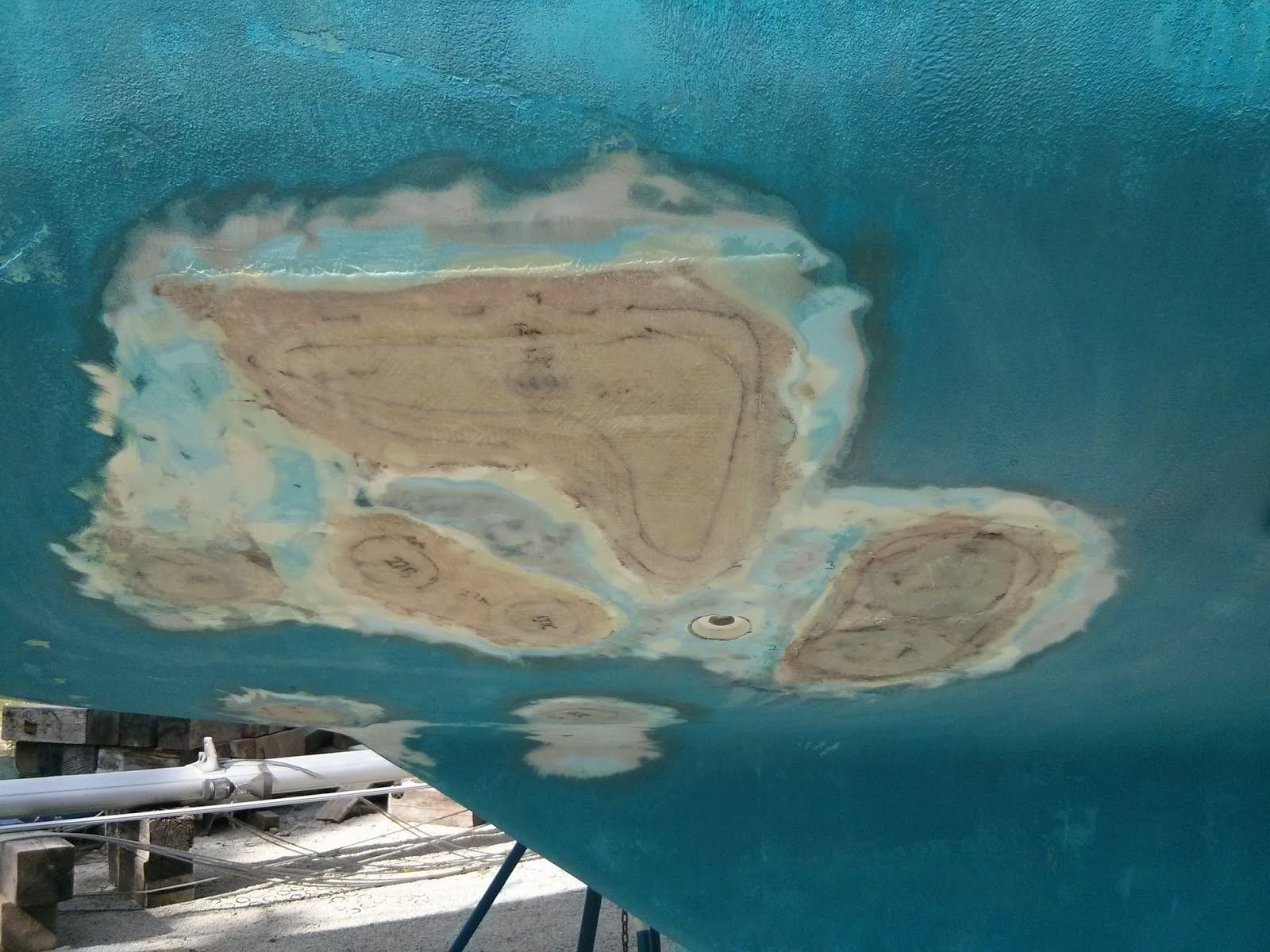All the original Morgan 382 thru hull fittings were flush
with the exterior hull. To accommodate
the exterior flange of the flush thru hull fitting, raised areas of fiberglass
protrude into the interior of the hull. On
Pilgrim we decided to reuse one of the original flush mounted thru hull sites,
the head sink drain. Creating a seacock
pad atop the interior protrusion proved much more complicated than installing
the seacock pads in other parts of the hull (see Four
Out of Five Seacock Pads Install Easily)
The process began by creating a plug to prevent the interior
epoxy work from fouling the exterior recess.
The exterior recess must mate well to the mitered flange of the thru
hull fitting to ensure a water tight fit.
Allowing excess epoxy to mar the exterior surface must be avoided.
 |
| Top: The duct tape wrapped PVC pipe used to temporarily plug the existing hole in the hull. Bottom: The new marelon recessed thru hull fitting |
A scrap of PVC pipe
closely matched the outside diameter (OD) of the existing hole in the hull. Adding a few wraps of duct tape ensured a
snug fit and covered the hollow end of the pipe. Epoxy does not create a strong bond with
either side of duct tape so taping over the pipe will also make it easy to
remove once the epoxy has cured.
 |
| The exterior view of the hole with the plug inserted. |
Inserted from the outside the PVC & duct tape plug fit the hole well.
 |
| The interior view of the hole with the plug in place. |
With the hole in the hull plugged, I headed inside Pilgrim
to install the first layer of the seacock pad.
The seacock pad for this site consists of two layers of 3/8”
G10 board. The first layer has large
hole in the center to accommodate the bulge in the hull. Layer one was set in position using epoxy
thickened with a combination of microfibers and cabosil.
 |
| The first layer of the seacock pad with grey epoxy filling the center cutout. |
After allowing the epoxy
to cure overnight, I washed down and ground smooth the first layer of
the new seacock pad.
To maintain proper alignment of top layer while the epoxy
cures, I plan to insert a ¼” machine screw through a pilot hole in both layers. The ¼” hole is ideal since I have plenty of ¼”
machine screws around and the hole diameter matches the size of my hole saw
arbor bit. It is
very important the ¼” pilot hole be centered precisely in the existing hole in
the hull as it will serve as a guide when boring out the seacock pads to accept
the new thru hull fitting.
To precisely locate the center of the existing thru hull
hole, I hand turned a hole saw matching the diameter of the thru hull hole in
the original hole. The tip of the hole
saw arbor bit marked the center of the original hole. Using the center mark on the outside of the hull as a guide, I drilled a ¼” hole through the new layer of thickened epoxy that now
filled the center of the first layer of the seacock pad.
I then went inside Pilgrim and taped the second layer of the
seacock pad atop the first. Then back
outside to mark the hole on the second layer with a pencil. Then back inside to remove the tape. Then over to the shop to drill the ¼” hole in
the pad on the drill press.
 |
| Ready to epxoy together the two layers of the seacock pad. |
After many trips in and out of the boat, I finally had
matching holes in the two layers of the seacock pad. Waxing the ¼” machine screw used to align the
layers prevents the epoxy from sticking to the screw.
 |
| Top Right: The two layers of the seacock pad assembled and curing Bottom left: Recently installed seacock pad for blackwater discharge thru hull. |
I used another round of epoxy thickened with micro fibers
and cabosil to secure the second layer atop the first.
 |
| Exterior view of thru hull recess with machine screw securing the interior assembly. |
Next a quick outside inspection to ensure no epoxy squished out on to the exterior recess. Now we
wait for the layup to cure.
What are those white stripes on the hull?
Good question! And
one I plan to answer in my next post.














